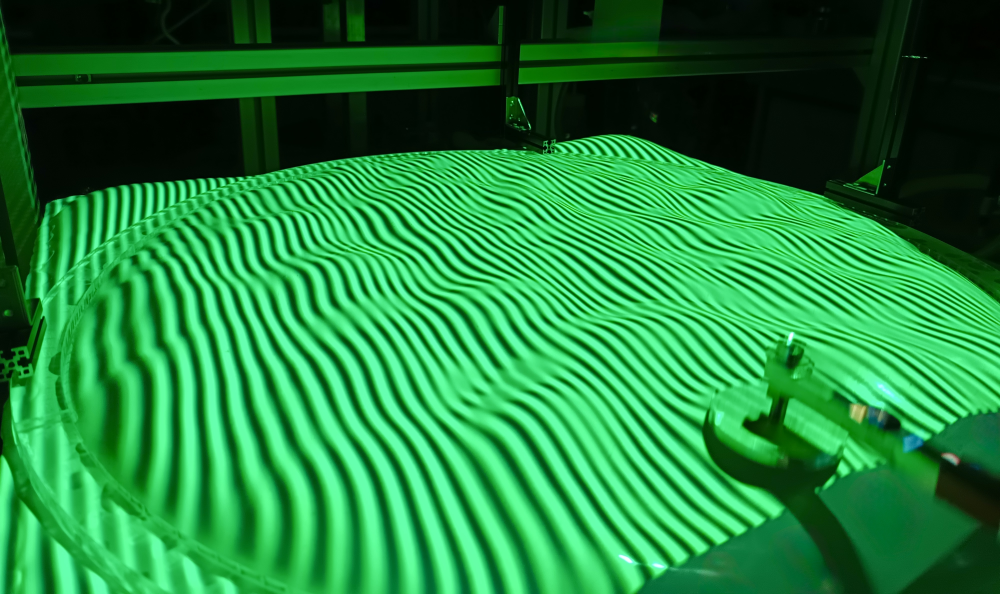Turbulent Waves Behave like a Gas
The large-scale behavior of turbulent waves is hard to predict, but it has important implications for climate modeling, weather forecasting, and even for understanding long-range interactions in quantum fluids. Now Marlone Vernet and Eric Falcon at the Paris Cité University and the French National Centre for Scientific Research (CNRS) have provided experimental evidence that some turbulent wave systems reach a balanced state, called statistical equilibrium, that is also observed in gases. Their observations show that the properties of these large-scale turbulent systems can be described using the concepts of classical thermodynamics, suggesting that their behavior could be predicted through the established tools of statistical physics [1].
The dynamic behavior of eddies, ripples, and other turbulent phenomena is often characterized as a nonlinear transfer, or “cascade,” of energy toward smaller scales. The transfer toward larger scales also plays an important role in energy redistribution, but it’s poorly understood. Physicists have conjectured since the 1950s that energy injected at small scales can generate large-scale turbulent features. In some systems, the energy becomes evenly distributed among these large-scale modes and no longer flows between them. This equilibrium state is directly equivalent to the thermal equilibrium of a gas, where the collective statistics of the gas particles can be used to determine bulk properties such as temperature and pressure. If similar statistics can be shown to apply to turbulent systems in the large-scale regime, physicists would have a handle for predicting their dynamics.
Numerical simulations have supported the idea that large-scale turbulence reaches an equilibrium state, but experimental evidence has only recently started to emerge. These experimental studies have focused on specific systems that can be prepared and measured in the lab and where the energy at small scales can be transferred to the large-scale regime. As an example, small ripples that form on a liquid’s surface have been shown to produce an equilibrium state that can be described by an effective temperature [2]. A previous experimental study by Falcon and another colleague in 2022 also measured an effective temperature for three-dimensional turbulent flow within a fluid, showing that the equilibrium state reached at large scales coexists with turbulent behavior at a smaller scale [3].
To investigate whether other concepts from thermodynamics can be applied to large-scale turbulent waves, Vernet and Falcon turned their attention to surface waves that form in water covered by a thin floating structure. The motion of the water causes the structure to bend and flex, resulting in a surface wave that is influenced both by the hydrodynamics of the fluid and by the elastic properties of the structure. An example of these so-called hydroelastic waves is an ice-covered sea, where ocean swells drive deformations in the floating ice sheet. Predicting the long-range dynamics of hydroelastic waves has become important for designing large offshore infrastructures, such as floating airports or solar-panel farms, that need to withstand the power of stormy seas. Theory also suggests that these hydroelastic waves should offer a suitable system for studying the coexistence of small-scale turbulence and statistical equilibrium in the large-scale regime.
To make their observations, Vernet and Falcon covered a large water tank with a thin sheet of silicone. Small-scale turbulent waves were generated by randomly shaking the sheet at a single location, and then optical techniques measured the vertical deformation of the sheet in space and time as the waves propagated across the surface. Placing a solid ring with a diameter of 60 cm on top of the sheet ensured that the waves were reflected equally in all directions and also avoided unwanted edge effects from the square sides of the tank.
The researchers found that the initial excitation of short, random waves eventually creates waves across longer scales. Their measurements showed that the wave energy becomes equally distributed across all modes of the wave system, confirming that it has reached statistical equilibrium. This finding is supported by frequency measurements at a single location on the sheet, which indicate that energy no longer flows between modes in the large-scale regime. These experimental observations almost exactly match theoretical predictions for the behavior of hydroelastic waves, which depend both on the movement of the water and the tension of the floating sheet.
Having confirmed that their experimental system reaches equilibrium, the researchers then applied the concepts of classical thermodynamics to compute bulk properties such as effective temperature, entropy, and heat capacity. They found that the effective temperature increases with the amount of agitation in the system, as measured by the amplitude of the small-scale waves. They also showed that the effective heat capacity, which quantifies the amount of energy stored in the wave system, is independent of the effective temperature—a feature that also describes an ideal gas. The effective heat capacity is, however, dependent on the number of wave modes in the large-scale regime, which is around 6000 in this experimental system.
“This new work by Vernet and Falcon provides additional evidence that wave systems evolve through a process of thermalization,” says Sergio Rica of the Pontifical Catholic University of Chile, who has previously studied a similar process in turbulent light waves. Indeed, the French researchers now plan to investigate the dynamics of thermalization in their system, specifically, how the large-scale waves decay when the source of small turbulent waves is switched off. “Our experiments open up new possibilities for using statistical physics to describe the large scales of turbulent systems that have reached statistical equilibrium,” comments Falcon.
–Susan Curtis
Susan Curtis is a freelance writer based in Bristol, UK
References
- M. Vernet and E. Falcon, “Thermodynamics and statistical equilibrium of large-scale hydroelastic wave turbulence,” Phys. Rev. Lett. (2025).
- G. Michel et al., “Observation of thermal equilibrium in capillary wave turbulence,” Phys. Rev. Lett. 118, 144502 (2017).
- J.-B. Gorce and E. Falcon, “Statistical equilibrium of large scales in three-dimensional hydrodynamic turbulence,” Phys. Rev. Lett. 129, 054501 (2022).





